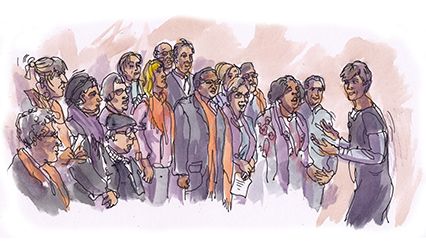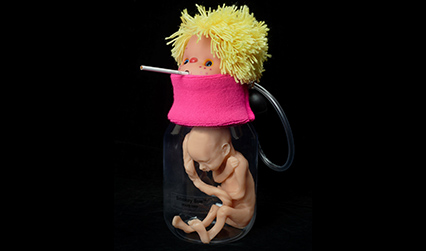How often do you think about breathing?
It is something we all do, every second, of every minute, of every hour, of every day. The average person will take approximately 7 million breaths in their lifetime. From a baby’s first cry to our last dying gasp, breath is a constant companion in our lives. It allows us to communicate, to convey emotion, to create works of art and to push the boundaries of what the human body is physically capable of achieving. So imagine how you would feel if you found yourself short of breath every day. How does it feel to be short of breath from just climbing a staircase, or getting dressed in the morning? Here at the Royal College of Physicians (RCP) we have worked with the Life of Breath research project to explore the meaning of breath and breathlessness in our latest temporary exhibition, Catch your breath.

The meaning of breath
The exhibition examines the use of breath in art, literature and cultures from around the world, to reveal that breathing is so much more to us than just a bodily function. Nowhere is this more apparent than in its significance to many world religions. To illustrate this in our exhibition we have a bible dating from the late 15th century, open to Genesis 2:7
Then the Lord God formed man of dust from the ground, and breathed into his nostrils the breath of life; and man became a living being.
Despite this significance, breath remains elusive. It is an invisible force, only becoming visible for fleeting moments in cold weather or as bubbles underwater. On display in Catch your breath are works by the artist Jayne Wilton, which use glass, copper and even 3D-printed plastic to try and visualise our breath. Wilton’s sculpture ‘Concern’ is the breath of a person speaking that word, captured and printed as a tangible, physical object.

Experiencing breathlessness
The importance of breathing is universal, but unfortunately 1 in 5 people in the UK will develop a lung disease such as asthma or COPD. Despite this high number, the stigma around breathlessness remains strong, leading to many people who experience it not seeking help or treatment. Many accept their breathlessness as an inevitable part of growing older, or see it as a consequence of their own actions, like smoking. This leads to many people with respiratory diseases not seeking help, not being diagnosed and therefore not receiving the treatment they need.
With Catch your breath, the RCP and LoB project want to bring the voices of people who experience breathlessness to the forefront of the exhibition. Voices of patients can be heard, alongside personal objects chosen by people with breathlessness which they feel illustrate how it feels to live with the condition day to day. The range of diseases that cause breathlessness is matched only by the range of ways people choose to manage the symptom, including practices like yoga and even singing in a choir. The Singing for Breathing choir at Royal Brompton & Harefield Hospital is an example of how new approaches to managing breathlessness are being used to complement more clinical treatments such as pulmonary rehabilitation.
Treating the Breath
For centuries doctors and medical professionals have tried many different methods to treat respiratory diseases. Some of these treatment methods are on display in Catch your breath. Although some may seem strange or even harmful to us today, they reflect the established medical thinking and practice of their time. For example, a popular treatment in the 17th century was to deliver medicine via a clyster, also known as an enema. On display in our exhibition we have a description of a treatment for shortness of breath from a Dr Salmon, which was delivered via an enema. Dr Salmon advises to administer the medicine in small amounts, so as not to put pressure on the diaphragm and risk exacerbating the patient’s breathlessness.
Other medical tools have proved altogether more useful to doctors and patients. The stethoscope, invented by the French physician René Laennec in 1816, is a crucial piece of equipment that enables doctors to diagnose respiratory diseases. Catch your breath contains a very early stethoscope, purported to have been owned by Laennec himself. Stethoscopes allow doctors to hear the sounds our lungs make when we inhale and exhale, listening for noises like wheezing, rattling or pleural rub, the noise made by the linings of the lungs rubbing together.

The air we breathe
As well as focussing on the function and meaning of the breathing, the exhibition also takes a look at the air we are breathing into our lungs. Disease can often find its way into our body through the air. The breath of others may contain dangerous particles of diseases like tuberculosis, or the passive smoke from a cigarette smoker. Even though the dangers of smoking were revealed to by the RCP Smoking and health report in 1962, smoking still remains the largest preventable cause of death worldwide. In Catch your breath, efforts to combat the habit are on display, like the educational doll Smokey Sue Smokes for Two. Smokey Sue was designed to educate women on the dangers of smoking whilst pregnant. When filled with water and given a lit cigarette, the water around Sue’s foetus slowly turns brown with tar, showing the damage smoking can do to an unborn child.

Air pollution also affects the air we breathe. In cities like London the sheer amount of vehicles on the roads pollutes our air with pollutants like carbon monoxide and sulphur dioxide. To try and combat this invisible threat to our lungs, some road users use protective masks, like the one we have on display for Catch your breath. The filters on display show the amount of pollution caught after three months use, alongside a clean filter for reference.
Matthew Wood, exhibitions officer
Catch your breath is open free of charge 9am–5pm, Monday–Friday until 20 September 2019. We’re hosting a series of events all about breathing and breathlessness to accompany the exhibition.
